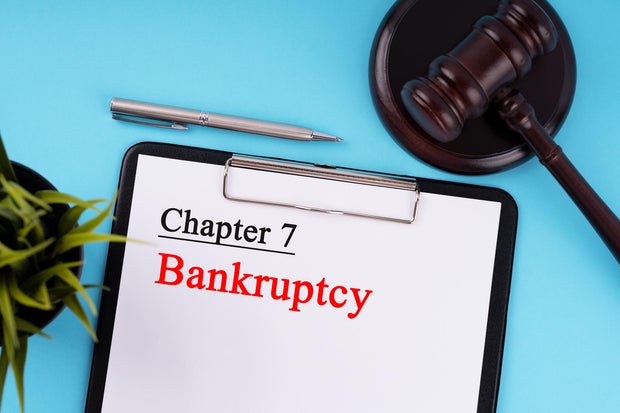
Chapter 7 vs. Chapter 13 bankruptcy: Which is better for credit card debt?
29. April 2025
Getty Images
Today’s economic climate is putting serious pressure on many American households. With inflation cooling but still higher than ideal and interest rates elevated, the cost of carrying debt — especially credit card debt — has gotten very expensive. With credit card rates averaging nearly 22% right now, many cardholders are struggling to make the minimum payments on their card accounts (which barely chip away at their balances), while the mounting interest charges that come with carrying a balance make it even harder to catch up.
As a result, an increasing number of people are finding themselves turning to bankruptcy as a solution. The numbers back this up: Personal bankruptcy inquiries rose in the first quarter of 2025, hitting their highest level since early 2020. Consumer stress has been elevated for the last three quarters, too — a clear sign that borrowers are struggling to manage their debt obligations in today’s challenging financial environment.
If you’re one of the many who are dealing with high-rate credit card debt and you feel like you’re running out of options, it’s important to understand that solutions are available. One of those solutions is bankruptcy. But when it comes to credit card debt specifically, is Chapter 7 or Chapter 13 bankruptcy the better choice?
Compare the debt relief strategies available to you today.
Is Chapter 7 or Chapter 13 Bankruptcy better for credit card debt?
Both Chapter 7 and Chapter 13 bankruptcy can help you wipe out or manage overwhelming credit card debt, but they work very differently, and the better option for you depends heavily on your financial situation.
Chapter 7 bankruptcy is often referred to as liquidation bankruptcy. It’s designed for people who truly can’t afford to pay their debts. If you qualify based on income (you must pass a means test), Chapter 7 allows you to erase most unsecured debts, including credit card balances, medical bills and personal loans, typically within a few months. To do that, though, you may have to give up certain non-exempt assets, like a second home or valuable collectibles. That said, many people who file for bankruptcy can keep essentials like their primary home, car and personal items through exemptions.
If your goal is to get out from under your credit card debt quickly and you don’t have a lot of assets you’re worried about losing, filing for Chapter 7 bankruptcy could be the better fit. However, it’s important to know that a Chapter 7 bankruptcy will stay on your credit report for up to 10 years, and it can significantly impact your ability to get new credit or favorable rates in the near term.
Chapter 13 bankruptcy, on the other hand, is sometimes called reorganization bankruptcy. Instead of wiping out your debts immediately, filing for this type of bankruptcy sets up a repayment plan that usually lasts from three to five years. During that time, you pay back some or all of your debt based on what you can afford. At the end of the repayment period, any remaining eligible debt, including credit card balances, may be discharged.
Chapter 13 may be the better option if you have a steady income but just need time and a structured plan to catch up. It can also help you protect assets that might otherwise be at risk in Chapter 7. However, Chapter 13 bankruptcy stays on your credit report for up to seven years and requires you to stick to a strict budget and court-approved payment plan for several years.
In short, if you have little to no income and few assets you need to protect, Chapter 7 may be the fastest and simplest way to get a clean slate. If you have regular income and valuable assets you want to keep, Chapter 13 may be the safer and more strategic route.
Start the process of tackling your high-rate credit card debt today.
What other options do I have?
Bankruptcy can be a powerful tool, but it’s not the only option, and it’s worth exploring alternatives before you commit to filing.
Debt settlement (also known as debt forgiveness) could be an option if you have a lump sum of money (or can save up for one) to offer creditors in exchange for forgiving a portion of your debt. This can potentially resolve your credit card balances for less than what you owe, although it may hurt your credit in the short term.
A debt management plan through a credit counseling agency can also be a smart alternative. These programs combine your unsecured debts into a single monthly payment with lower interest rates and fees, making repayment more manageable. Over time, you’ll pay off your debt without having to declare bankruptcy.
Debt consolidation loans may be another solution to consider if your credit is still strong enough to qualify. By rolling multiple credit card balances into a single fixed-rate loan, you could lower your interest costs and simplify your payments.
The right solution will ultimately depend on your income, total debt load, assets and overall financial goals. Speaking with a certified credit counselor, financial advisor, debt relief expert or bankruptcy attorney can help you weigh your options.
The bottom line
If you’re struggling to make your credit card payments this May, you have options and bankruptcy is just one of them. Chapter 7 may offer a fast and total escape from credit card debt, while Chapter 13 can give you time to reorganize and protect valuable assets. But bankruptcy isn’t a decision to take lightly, and it’s critical to understand the long-term impact on your financial future.
Before deciding on any path, take the time to explore all your alternatives. Whether you ultimately file for bankruptcy or pursue another form of debt relief, taking action now can help you regain control of your finances and start building a healthier financial future.
